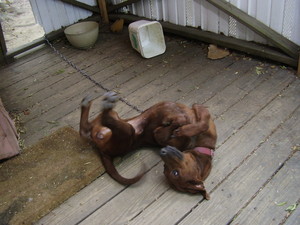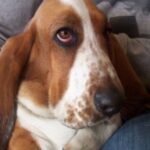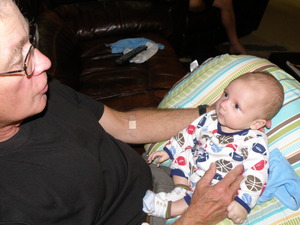Hounds as a group are not for everyone. They require patience and room, and often aren’t good with close neighbors due to their voices that carry. Developed, as a group, for hunting a loud bawling voice that carried across fields was an asset – something that isn’t an asset in suburban areas. However, with some training, discipline and an outlet to burn up energy hounds can be wonderful pets.
It is best to use caution with hounds around small animals – cats can be seen as something to chase and kill. One person complained that her beagle barked nonstop when he was in the back yard by the rabbit hutch – beagles are bred to hunt rabbit so of COURSE the dog would bark!
1. Beagle – With 13 and 15 inch varieties the Beagle is a dinstinctive gentle dog that has been, past and present, a hunting dog as well as pet. In 1888 the national club was formed and held the first field trial. They don’t drool, have minimal shedding and are a tough dog in a small size. President Lyndon B Johnson kept three Beagles and the Beagle has been the star of movies like Shiloh.
2. Greyhound – Famous for their abilities on the racetrack Greyhounds are often seen as too “hyper” for many homes. The truth is with proper exercise many retired greyhounds can be couch potatoes. Generally 60-70 pounds this is a very old breed dating back to 2900 B.C. and once kept by General George Custer. The hare is the natural game – so the breed should be kept very cautiously with smaller animals including small dogs and cats.
3. American Foxhound – A breed going back to the 1700s the American foxhound is a great choice for those on larger farms in rural areas. There are field trial, fox hunting, trail and pack hounds found within this breed. The founding ancestors of the American Foxhound are hounds imported from England (English Foxhounds) by George Washington. A deep chest allows for lung capacity for running. Generally 21-25 inches the foxhound is an independent type dog. As with any dog with the deep chest bloat is a possibility – and something that owners need to be familiar with.
4. Basset hound – The short stature, about 14 inches, and long ears with hound coloring make the Basset a favorite. Like the Beagle they come in any hound color without preference and were bred to hunt rabbits. Their nose for tracking is said to be second only to the Bloodhound, and the breed can be (like many hounds) incredibly stubborn. This is for the most part NOT a group for those with little or no patience.
5. Black and Tan Coonhound – A 23-27 inch hound this breed is black and tan was developed as a hunting breed – and even in the standard scars from “honorable wounds” are not considered faults, but white markings are. Like other hounds they LOVE people – some may be reserved but not vicious. An even, friendly temperment is typical. A powerful breed they are a more recent addition to the AKC books, but as a breed date back to 11th century England. It is a color breed bred for possum and raccoon – sometimes said to be slower hunters than other coonhounds. They’re also keen to hunt, with training, big game including cougar and bear.
6. Borzoi – Long called the Russian Wolfhound this beautiful breed is one of the larger hounds with a minimum 26 inches for bitches, 28 for males. Bred for running down game they were known as speedy sighthounds, relying more on vision than nose to follow and capture the game. One of the traditional targets was the wolf. Their lanky bodies and athletic abilities are deceptive in that they can be up to 100 pounds and were once kept only by nobility. Dating to the 17th century this is an ancient and established breed.
7. Dachshund – With three distinct looks – smooth, wire and long haired – this breed is low to the ground with standards 16-32 pounds and miniatures 11 pounds and under. The smooth is the most common, short coated variety while the long hair has setter like hair and the wire having a wire coat. The breed was developed more than 300 years ago as a badger dog and despite their lap dog reputation they can still be considered hunters.
8. Redbone coonhound – The Redbone was made famous in the book “Where The Red Fern Grows”, a tale of Dan and Anne and a young coonhunter. Always red in color and without white markings this medium sized hound was developed for hunting mostly small game. Ranging from 21-27 inches they’re slightly taller in the front than hips. They’re an even tempered dog but aggressive hunter and have been known to kill cats, a factor if you also have feline pets. They get along well with other dogs, and are a great family dog. They’re good swimmers and were bred largely from Scottish and Irish hounds for a good nose for tracking.
9. Scottish deerhound – Only those with large yards or in the country should really consider this breed – a large breed that can be 28-32 inches and 100 pounds at the upper range of size. Often seen as a rough coated greyhound, this breed is a gentle giant and although large in size often do not make good guard dogs. At one point they were exclusively for nobility and no one lower than an earl could posess one. Like many sighthounds they excell at lure coursing; they are rare and have excellent hunting abilities, often being hunted alone or in pairs.
10. Whippet – Often viewed as a smaller greyhound the whippet is indeed a small sight hound. Ideally 18-22 inches in size this smooth coated breed is friendly and gentle but speedy in lure coursing competitions. Originally bred to chase down and catch small game they are one of the hounds less likely to bark unnecessarily. They can cover ground at up to 35 miles an hour.
Hounds can be a delight – but often due to their history can be independent thinkers, “stubborn” and “difficult.” Hounds should be kept only with a securely fenced yard – far too many hit a scent and run for miles after their object of interest. Unfortunately they are often so intent on their quarry they can run into traffic and many are hit by cars, never imagining people would hurt them. Most hound owners do *not* recommend underground fence and other systems – secure containment is needed for the safety of the hound. They’re a wonderful group to find a pet if you have the right home, and typically are wonderful dogs with kids as well as adults. Know what you’re getting into with them and be prepared for a lifetime of love and entertainment when you have a hound.




